MCQ on Lines and Angles Class 6
Class 6 Maths Chapter 2 MCQ Lines and Angles
Multiple Choice Questions
Question 1.
Which of the following has no endpoints?
(a) Line
(b) Ray
(c) Line-segment
(d) None of these
Answer:
(a) Line
Question 2.
Number of lines which can be drawn passing through two given points:
(a) 1
(b) 2
(c) 3
(d) An infinite number
Answer:
(a) 1
![]()
Question 3.
Number of right angles turned by the hour hand of a clock when it goes from 3 to 6.
(a) 1
(b) 2
(c) 3
(d) 4
Answer:
(a) 1
Question 4.
The measure of a straight angle is
(a) 90°
(b) 360°
(c) 180°
(d) None of these
Answer:
(c) 180°
Question 5.
A dot gives us an idea of a ___________
Answer:
Point
Question 6.
A line has ___________ end points.
Answer:
No
Question 7.
How many line segments present in figure given below? (Medium) [CBSE Diksha]
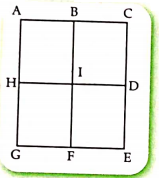
(a) 4 line segments
(b) 6 line segments
(c) 10 line segments
(d) 18 line segments
Answer:
Option (d) is correct
Explanation:
As the given figure has 18 line segments, these are AB, BC, AC, CD, DE, CE, EF, FG, EG, GH, HA, GA, BI, IF, BF, HI, ID and HD
Question 8.
Assertion (A): A short way to write ‘ray AB’ is AB.
Reason (R) : A ray has one end point and extends, without limit in one direction only. [A|7] (Medium)
(a) Both A and R are true
(b) Both A and R are false
(c) A is true, but R is false
(d) A is false, but R is true
Answer:
Option (a) is correct
Explanation:
Ray AB is written as AB as it has end point at A, and it extends without limit in one direction. So both A and B are true.
Question 9.
John turns right three times. How many degrees does he turn through?
(a) 90°
(b) 180°
(c) 330°
(d) 270°
Answer:
Option (d) is correct.
Explanation:
In one turn he moves 90°.
In three turns he moves through 90° × 3 = 270°.
Question 10.
The angle between two opposite rays is
(a) acute
(b) obtuse.
(c) straight
(d) right.
Answer:
Option (c) is correct.
Explanation:
Two opposite rays make an angle of 180°, i.e., straight angle.
Question 11.
The angle between the directions north and south is a right angle (True/False) (Easy)
Answer:
False
Explanation:
The angle between directions north and south is 180° (straight angle).
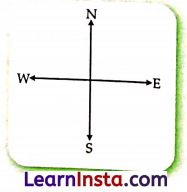
Look at the figure and fill in the blanks:
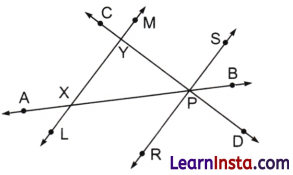
(i) The lines passing through P are: _______, _______ and _______
Answer:
\(\overline{\mathrm{RS}}\), \(\overline{\mathrm{AB}}\) and \(\overline{\mathrm{CD}}\)
(ii) The concurrent lines are: _______, _______ and _______
Answer:
\(\overline{\mathrm{AB}}\), \(\overline{\mathrm{CD}}\) and \(\overline{\mathrm{RS}}\)
(iii) The lines meet at X are: _______ and _______
Answer:
\(\overline{\mathrm{AB}}\) and \(\overline{\mathrm{LM}}\)
(iv) The lines CD and LM meet each other at _______
Answer:
Y
Note: Three or more lines passing through a single point are called concurrent lines.
Name all the line segments in the given figure.

(i) _____________
(ii) _____________
(iii) _____________
(iv) _____________
(v) _____________
(vi) _____________
Answer:
(i) \(\overline{\mathrm{AB}}\)
(ii) \(\overline{\mathrm{AC}}\)
(iii) \(\overline{\mathrm{AD}}\)
(iv) \(\overline{\mathrm{BC}}\)
(v) \(\overline{\mathrm{BD}}\)
(vi) \(\overline{\mathrm{CD}}\)
![]()
Fill in the blanks:
(i) A ray has _____________ end point(s).
Answer:
One
(ii) A line \(\overline{\mathrm{PQ}}\) extends in _____________ directions.
Answer:
Both
(iii) The measure of a 1\(\frac{1}{3}\) right angles = _____________ degrees.
Answer:
120°
(iv) The measure of 2 straight angles is _____________
Answer:
360°
(v) The measure of _____________ is between 180° and 360°.
Answer:
Reflex Angle
(vi) A clock hand will reach at _____________ if it starts at 7 and makes \(\frac{1}{2}\) of a revolution.
Answer:
1
(vii) The angle included between the arms of a clock at 10 o’clock is _____________ degrees.
Answer:
60°
(viii) You will make _____________ right angles, if you start facing North and turn anticlockwise to East.
Answer:
3
(ix) In the figure, various line segments are:
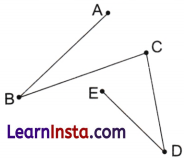
(i) _____________
(ii) _____________
(iii) _____________
(iv) _____________
Answer:
(i) \(\overline{\mathrm{AB}}\)
(ii) \(\overline{\mathrm{BC}}\)
(iii) \(\overline{\mathrm{CD}}\)
(iv) \(\overline{\mathrm{DE}}\)
(x) How many right angles are turned by the hour hand of a clock when it moves:
(i) from 2 to 5?
(ii) from 4 to 10?
(iii) from 12 to 3?
(iv) from 9 to 3?
Answer:
(i) 1
(ii) 2
(iii) 1
(iv) 2
Fun Activity
Complete the following crossword puzzle:
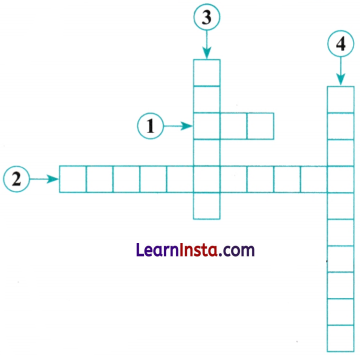
Across:
(1) A _____________ is a part of lines starting at a point and extends in one direction endlessly.
(2) A _____________ is a portion of a line whose endpoints are fixed.
Down:
(3) The meeting point of arms of an angle is called a _____________
(4) _____________ is used to measure an angle.
Answer:
Across:
(1) Ray
(2) Line Segment
Down:
(3) Vertex
(4) Protractor
![]()
Tick the correct option:
(i) A line segment has [two/no] endpoints.
Answer:
two
(ii) The measure of a full turn is [180°/360°]
Answer:
360°
(iii) The measure of an [acute/obtuse] angle is between 90° and 180°.
Answer:
Obtuse
(iv) The endpoints of a line segment [are/are not] the part of its length.
Answer:
are
(v) When the clock shows 3 o’clock the angle between its hand is equal to [60°/90°].
Answer:
90°
(vi) 4 right angles equal to one [straight angle/full turn].
Answer:
full turn
Match the following:
Question 1.
| Column A | Column B |
| (a) A line | (i) measure |
| (b) A line segment can be | (ii) extends infinitely in one direction. |
| (c) A ray | (iii) measured |
| (d) In an angle, the lengths of the arms do not affect its | (iv) extends infinitely in both directions. |
Answer:
| Column A | Column B |
| (a) A line | (iv) extends infinitely in both directions. |
| (b) A line segment can be | (iii) measured |
| (c) A ray | (ii) extends infinitely in one direction. |
| (d) In an angle, the lengths of the arms do not affect its | (i) measure |
Question 2.
Measure and classify each angle:
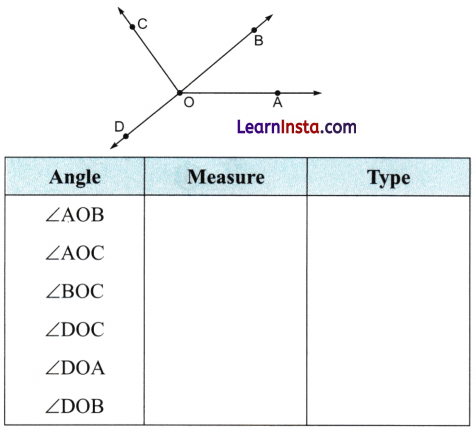
Answer:
| Angle | Measure | Type |
| ∠AOB | 40° | Acute Angle |
| ∠AOC | 125° | Obtuse Angle |
| ∠BOC | 85° | Acute Angle |
| ∠DOC | 95° | Obtuse Angle |
| ∠DOA | 140° | Obtuse Angle |
| ∠DOB | 180° | Straight Angle |
Question 3.
Match the following given angles with its measure:
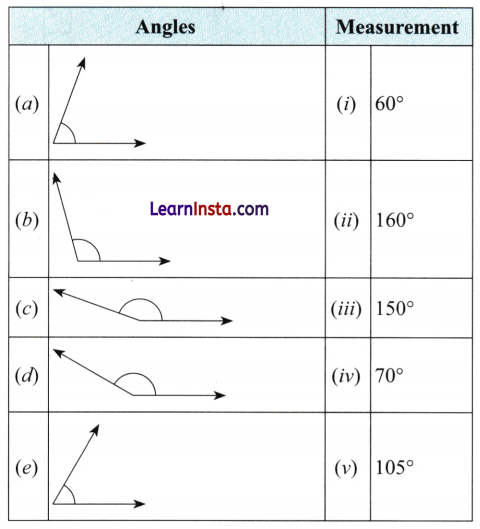
Answer:
(a) (iv)
(b) (v)
(c) (ii)
(d) (iii)
(e) (i)
Answer the following.
Question 1.
Can we have two acute angles whose sum is
(i) an acute angle? Why or why not?
Answer:
Yes. The sum of two acute angles is again an acute angle.
For example: 15° and 35° two acute angles and 15° + 35° = 50°, an acute angle.
(ii) a right angle? Why or why not?
Answer:
Yes. The sum of two acute angles may be equal to a right angle.
For example: 35° and 55° are two acute angles and 35° + 55° = 90°, a right angle.
(iii) an obtuse angle? Why or why not?
Answer:
Yes. The sum of two acute angles may be an obtuse angle.
For example: 45° and 55° are two acute angles and 45° + 55° = 100°, an obtuse angle.
(iv) a straight angle? Why or why not?
Answer:
No. The sum of two acute angles is always less than a straight angle.
As, acute angles are less than 90°, so the sum of two acute angles is always less than 180°, a straight angle.
(v) a reflex angle? Why or why not?
Answer:
No. The sum of two acute angles is always less than a reflex angle.
As, sum of two acute angles are always less than 180°, so it is always less than a reflex angle.
![]()
Question 2.
Can we have two obtuse angles whose sum is
(i) a reflex angle? Why or why not?
Answer:
Yes. The sum of two obtuse angles is always greater than 180°, a reflex angle.
(ii) a full turn? Why or why not?
Answer:
No. The sum of two obtuse angles is always greater than 180°, but less than 360° a full turn.
Question 3.
An angle is said to be trisected, if it is divided into three equal parts. If in the figure shown here, ∠BAC = ∠CAD = ∠DAE, how many trisectors are there for ∠BAE?
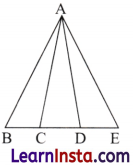
Answer:
Two, AC and AD
Question 4.
In the given figure,
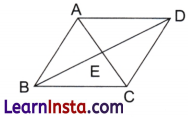
(i) name any four angles that appear to be acute angle.
Answer:
∠ABE, ∠ADE, ∠BAE, ∠BCE (Answer may vary)
(ii) name any two angles that appear to be obtuse angle.
Answer:
∠BCD, ∠BAD
Question 5.
If a bicycle wheel has 36 spokes, then answer the following:
(i) What is the angle between its two adjacent spokes?
Answer:
10°
(ii) What is the angle between a spoke and its neighbouring 4th spoke?
Answer:
30°
Question 6.
Assertion: A straight angle contains 2 right angles.
Reason: Measure of right angle is 90° and measure of a straight angle is 180° that is 180° = 2 × 90°.
In the given question, a statement of Assertion is followed by a statement of Reason. Choose the correct option as:
(a) Both assertion and reason are true and the reason is the correct explanation of assertion.
(b) Both assertion and reason are true but the reason is not the correct explanation of the assertion.
(c) Assertion is true and the reason is false.
(d) Assertion is false and the reason is true.
Answer:
(a) Both assertion and reason are true and the reason is the correct explanation of assertion.
Question 7.
Puzzle: I am an acute angle. If you double my measure, you get a right angle. If you triple my measure, you will get an obtuse angle. If you quadruple (four times) my measure, you will get a straight angle! Who am I?
Answer:
45°
![]()
Case Based Question
Five friends say A, B, C, D and E are sitting along the bonfire by maintaining a distance like the given figure. Where O is the position of bonfire.
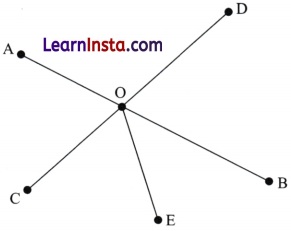
Based on the above information, answer the following questions.
(a) Which two friends are sitting next to each other in a way, such that an obtuse angle is formed between them with respect to bonfire?
Answer:
A and D
(b) Which type of angle is formed between A and C?
Answer:
Acute Angle
(c) Which angle is formed between A and B?
Answer:
Straight Angle